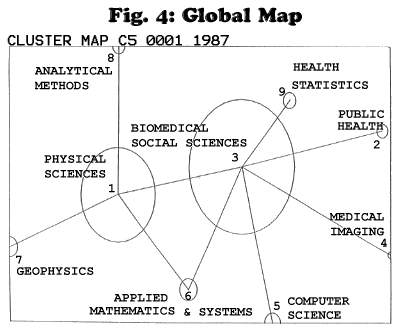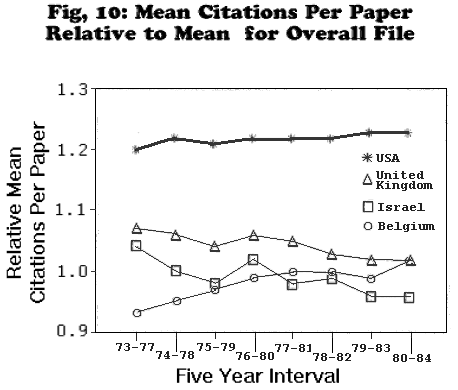IDENTIFYING THE CHANGING FRONTIERS OF SCIENCE
E. Garfield and H. SmallIn this paper we will illustrate how the ISI database can be used to identify and map research fronts across many fields of science. This workshop is concerned with how science is transformed into technology and eventually new goods and services which contribute to economic growth. Much has been written about this complex process and many theories put forward�1,2. Ours is not a case study, or a theory of the innovation process. Rather it presents a possible scenario of how a specific bibliometric methodology might be used to foster an innovation within a country such as Israel.
We begin with some theoretical speculations and assumptions. We hypothesize that there are such things as �hot� fields or emerging areas in science, and that we have a way of identifying them bibliometrically, that is, by a systematic and quantitative analysis of the scientific literature. Second, that it is possible to identify for a country or other geographic entity the extent of its scientific research in specific areas as evidenced by publication and citation patterns. Further, that we can determine the extent to which a country participates in the �hot� fields. Third, we assume that it is more effective to stimulate or augment a field which is already active in a given setting with investigators already dedicated to it than to create such an activity de novo where it did not exist before. Finally, we speculate (and this is the key point) that as a result of strengthening such �hot� spots in a country�s scientific effort, we can increase the likelihood that research will lead to practical applications, and ultimately economic benefit.
To illustrate this process, let us take an actual example for Israel, drawn from our 1987 cluster analysis of the Science Citation Index and Social Sciences Citation Index. I will not attempt to explain how clustering is actually carried out. There are many methods one could apply and we have experimented with only a few of them. In capsule, our method uses highly cited papers (core papers), a measure of association between them called co-citation, and single-link clustering routine.3
Let�s begin with the notion of a �hot� field. We know that modern science can progress very rapidly, and within a short period of time dramatic gains in knowledge can be made. In citation analysis we have an analogue to this, namely the number of highly cited papers that are of recent origin. We sometimes call this �immediacy�. By counting the number of �core papers� in each cluster published within the last 3 years, we have a simple and powerful measure of immediacy. In other words, in an area of science with high immediacy there have been a number of important recent findings.
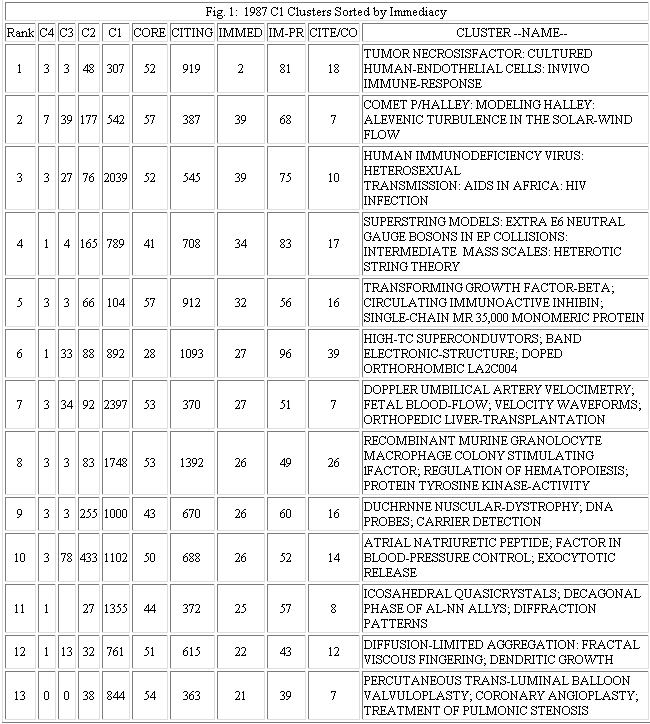 Figure
1 shows the clusters from our 1987 database that have the most core papers
from �87, �86, and �85. This number is given in the column labeled IMMED.
Since we know that of all 54,095 core papers in 1987, only 14% come from
these 3 most recent years, the clusters shown here all have a high degree
of immediacy.
Figure
1 shows the clusters from our 1987 database that have the most core papers
from �87, �86, and �85. This number is given in the column labeled IMMED.
Since we know that of all 54,095 core papers in 1987, only 14% come from
these 3 most recent years, the clusters shown here all have a high degree
of immediacy.
The next problem is how to select the high immediacy or �hot� fields
for a particular country such as Israel? One way is to look at the author
addresses of all the papers that cite the core documents in a cluster,
and compute the percentage of these citing papers for the country in question.
Figure 2 shows the same clusters for Israel, specifically selected for
having 12 or more Israeli core papers and 8% or more of their total citing
papers from Israel. These are all areas where Israel has a significant
amount of research already going on. We know the percentage of papers in
our complete file published in Israel is about 1%. In other words, the
total citing population from Israel is only slightly over 1%. Hence any
cluster producing papers above this level may represent an area of concentration
for the country.
Fig.2: 1987 Research Fronts with > 12 Papers and > 8% Total Papers from Israel
| C1 Cluster | Core Size | Citing Papers | Israel Papers | % Israel | * Immed | Name |
| 1263 | 31 | 677 | 6.5 | 9.6 | 9 | lupus anticoagulant in systematic lupus-erythematosus (biomedicine) |
| 1431 | 22 | 234 | 48 | 20.5 | 0 | evolution of the Dead Sea Jordan rift system (geology) |
| 5888 | 3 | 111 | 35 | 31.5 | 0 | hairy-cell leukemia (biomedicine) |
| 5792 | 5 | 231 | 28 | 12.1 | 0 | differentiation of murine erythroleukemia cells (biomedicine) |
| 5210 | 5 | 178 | 25 | 14.0 | 0 | vitamin-D metabolism (biomedicine) |
| 570 | 10 | 165 | 22 | 13.3 | 2 | entamoeba-histolytica infection (medicine) |
| 1086 | 26 | 112 | 21 | 18.7 | 3 | posttraumatic stress disorder (psychology) |
| 2335 | 10 | 231 | 20 | 8.6 | 1 | blood-pressure control in children's medicine |
| 1860 | 6 | 199 | 18 | 9.0 | 0 | rat peritoneal mast-cells (biomedicine) |
| 2254 | 13 | 153 | 18 | 11.7 | 6 | random resistor network (physics) |
| 5984 | 5 | 60 | 17 | 28.3 | 0 | suspected tibial stress-fractures (medicine) |
| 3136 | 2 | 151 | 17 | 11.2 | 0 | mouse bone-marrow cells (biomedicine) |
| 3889 | 7 | 171 | 16 | 9.3 | 1 | subacute cutaneous lupus-erythematosus (medicine) |
| 238 | 4 | 60 | 16 | 26.6 | 2 | organic solid-state reactions (chemistry) |
| 8313 | 2 | 38 | 13 | 34.2 | 0 | social support (psychology) |
| 6803 | 2 | 153 | 13 | 8.5 | 0 | differentiation of HL-60 promyelocytic leukemia-cells (biomedicine) |
| 2877 | 3 | 74 | 12 | 16.2 | 0 | plasma parathyroid-hormone (biomedicine) |
| 4649 | 5 | 90 | 12 | 13.3 | 0 | copper deficiency (biomedicine) |
*Immed = number of core papers with publication years within the last 3 years, i.e., 1985, 1986 and 1987
To pick the �hot� fields which Israel is strong in, we simply look down the IMMED column until we see a cluster above 14% in immediacy. On this list two jump out �lupus erythematous� (#1263) with 9 of 31 recent core papers and �random resistor networks� (#2254) with 6 of 13. Both areas currently have Israeli participation by citing authors well above the 1% expected level, 9.6% and 11.7% respectively.
Another way we can look for country strength is by the addresses of
the core papers themselves. This indicates that a leading researcher or
perhaps a research group is working in a given country on a specific topic.
Addresses of cited papers require more effort to retrieve so we have only
generated a partial analysis of 1987 clusters with 2 or more core papers
from Israel with publication dates between 1973 and 1984 (Figure 3).[See
table below]
|
|
|||||
|
|
|
|
|
from Israel |
|
|
|
|
|
|
|
evolution of the Dead-Sea Jordan rift systems |
|
|
|
|
|
|
deterministic chaos |
|
|
|
|
|
|
Sierpinski carpets; fractal lattices |
|
|
|
|
|
|
quasi-one-dimensional conducting polymers |
|
|
|
|
|
|
treatment of acute pelvic inflammatory disease |
|
|
|
|
|
|
fractal dimensions |
|
|
|
|
|
|
passive hyperthermia in humans |
|
|
|
|
|
|
anisotropy of magnetic-susceptibility |
|
|
|
|
|
|
lectin receptor expression |
|
|
|
|
|
|
propagation of stationary non-adiabatic combustion waves |
|
|
|
|
|
|
random field Ising-model |
|
|
|
|
|
|
isovector monopole resonances in N-not-equal-Z nuclei |
|
|
|
|
|
|
interacting Boson model |
|
|
|
|
|
|
threshold voltage in thin oxide mosfet |
|
|
|
|
|
|
anomalous diffusion |
|
|
|
|
|
|
regulation of hematopoiesis |
|
|
|
|
|
|
small nuclear ribonucleoprotein-particles |
|
|
|
|
|
|
phytoplanktin in coastal waters |
|
|
|
|
|
|
membrane fluidity |
We are in the process of updating this analysis to 1987 so this is only an interim result.
Despite this limitation an interesting pattern emerges. We find that a general area of physical science sometimes referred to as �chaos� (4) is associated in Israel with a number of leading institutions including the Hebrew University, Tel Aviv University, the Weizmann Institute, and the Technion. The �random resistor network� cluster also falls in this general area, and hence we have selected it as our example, although any number of others might have suited our purpose equally well. In passing we note that Benoit Mandelbrot has co authored with Israelis on chaos.
As a next step let us orient ourselves to the field of chaos and within it, random resistor networks. At ISI we have developed methods for visualizing the complex web of research areas by what we call cluster mapping. (5) Cluster mapping utilizes the co-citation linkages between papers and clusters of papers, applies multidimensional scaling to those links to arrive at a two dimensional display of the relations between areas. Since our clustering is iterative and hierarchical we are also able to show various levels of detail from a very broad disciplinary view down to the individual research specialty composed of core papers. We illustrate this by a succession of maps, each nested within the one before it.
First, we show what we call a �global map� which is the most inclusive map we can draw (Figure 4). It is comprised mainly of two large groupings, one labeled physical sciences and the other biomedical and social sciences. The remaining smaller circles are various physically or biologically oriented sub-fields which are insufficiently linked to the major disciplinary groups to be encompassed by them, but not so isolated from them to fall off the map entirely.
 Since
our selected area is within the physical science circle, we blow up the
display for it at the next lower level (Figure 5 [at left]). Now we see
three major groups: chemistry, physics and geoscience and also a number
of smaller groupings. One of these smaller ones is labeled �chaos� and
it is closely allied to physics.
Since
our selected area is within the physical science circle, we blow up the
display for it at the next lower level (Figure 5 [at left]). Now we see
three major groups: chemistry, physics and geoscience and also a number
of smaller groupings. One of these smaller ones is labeled �chaos� and
it is closely allied to physics.
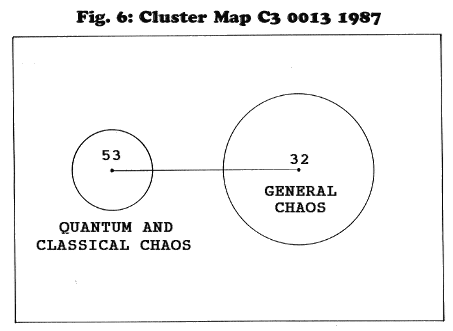 Zeroing
in on this area (Figure 6 [at right]), we see initially not much structure:
two very closely related groups, one labeled �classical and quantum chaos�
and the other �general chaos�.
Zeroing
in on this area (Figure 6 [at right]), we see initially not much structure:
two very closely related groups, one labeled �classical and quantum chaos�
and the other �general chaos�.
The circle on the right is the one we want and entering it (Figure 7 [below left]) we get our first glimpse of the cluster we are seeking, namely, �random resistor networks� (#2254).
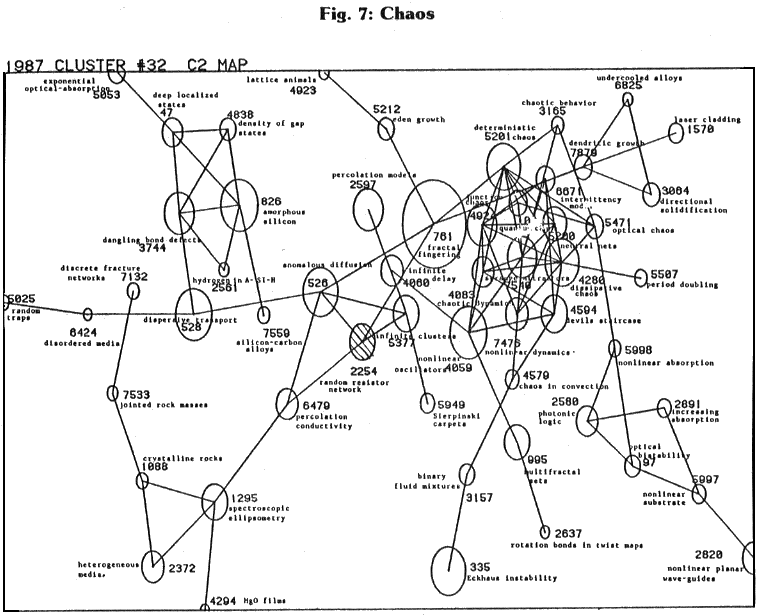 We
note the diverse structure of this �chaos� map with some unusual nomenclature
such as �strange attractors� �eden growth� �lattice animals� etc. We noted
before that Israeli scientists played a leading role in several of these,
for example, #5201 on �deterministic chaos� #5949 on �Sierpinski carpets�
and #526 on �anomalous diffusion� Note the proximity of these areas to
our chosen example, �random resistor networks� #2254, in the center of
the map.
We
note the diverse structure of this �chaos� map with some unusual nomenclature
such as �strange attractors� �eden growth� �lattice animals� etc. We noted
before that Israeli scientists played a leading role in several of these,
for example, #5201 on �deterministic chaos� #5949 on �Sierpinski carpets�
and #526 on �anomalous diffusion� Note the proximity of these areas to
our chosen example, �random resistor networks� #2254, in the center of
the map.
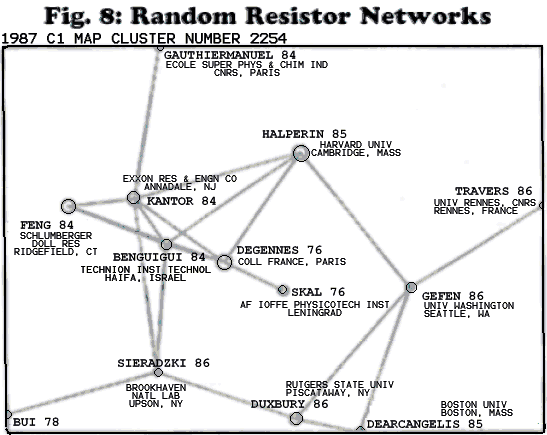 Now
we enter cluster 2254 (Figure 8 [at right]) and see its internal structure
in terms of the core papers that comprise it. We are first struck by the
international diversity of its authors: U.S.A., France, Soviet Union and
Israel. The last named country is represented by a paper from the Technion
in Haifa whose first author is Ben Guigui, published in Phys Rev Letters
in 1984 (Figure 9).[See Table below]
Now
we enter cluster 2254 (Figure 8 [at right]) and see its internal structure
in terms of the core papers that comprise it. We are first struck by the
international diversity of its authors: U.S.A., France, Soviet Union and
Israel. The last named country is represented by a paper from the Technion
in Haifa whose first author is Ben Guigui, published in Phys Rev Letters
in 1984 (Figure 9).[See Table below]
|
|
||||||||
|
|
|
|
|
citations
|
||||
| 1 | 13 | 32 | 2254 | BENGUIGUI L | PHYS REV LETT | 53:2029, | 1984 |
17
|
| 1 | 13 | 32 | 2254 | BUI HD | MECANIQUE RUPTURE FR | 0: 0, | 1978 |
8
|
| 1 | 13 | 32 | 2254 | DEARCANGELIS L | J PHYS LETT PARIS | 46:3585, | 1985 |
12
|
| 1 | 13 | 32 | 2254 | DEGENNES PG | J PUYS LETT PARIS | 31:3001, | 1976 |
31
|
| 1 | 13 | 32 | 2254 | DUXBURY PM | PHYS REV LETT | 57:1052, | 1986 |
18
|
| 1 | 13 | 32 | 2254 | FENG S | PHYS REV LETT | 52: 216, | 1984 |
23
|
| 1 | 13 | 32 | 2254 | GAUTHIERMANUEL B | J PHYS E | 17:1177, | 1984 |
7
|
| 1 | 13 | 32 | 2254 | GEFEN Y | PHYS REV LETT | 57:3097, | 1986 |
8
|
| 1 | 13 | 32 | 2254 | HALPERIN BI | PHYS REV LETT | 54:2391, | 1985 |
27
|
| 1 | 13 | 32 | 2254 | KANTOR Y | PHYS REV LETT | 52:1891, | 1984 |
22
|
| 1 | 13 | 32 | 2254 | SIERADZKI K | PHYS REV LETT | 56:2509, | 1986 |
7
|
| 1 | 13 | 32 | 2254 | SKAL AS | SOV PHYS SEMICOND | 8:1029, | 1975 |
12
|
| 1 | 13 | 32 | 2254 | TRAVERS T | J PHYS A | 19:1033, | 1986 |
7
|
When we recall again that 11 percent of the papers citing these core papers have Israeli authors, we know that we have a focal point of Israeli activity, and this focus broadens to adjacent, and closely allied topics in �chaos�. This activity is significant both from the standpoint of important work being done (i.e. a leadership role in the field) and a significant quantity of active research workers laboring in these fields (i.e. followers).
In short, it seems that we have here a �hot� field with significant indigenous strength, which might be an ideal case to foster and stimulate for future economic payoff. Of course, the problem is we have no way of knowing whether there will ever be such practical spin-offs of this basic science endeavor. The beauty of basic science is simply that we can never tell for sure. Nature is full of surprises. However, putting a bet on an emerging field where local talent is already at work, seems as sound a basis for investment in basic research as can be devised.
This is not to say that all is well with basic science in Israel. In fact, we have reason to believe that it is in decline and in need of increased support and stimulation. Using our new Science Indicators file covering the years 1973 to 1984 (6) (soon to be updated to 1987), we have produced the graph of Figure 10 [right] which plots the mean number of citations per paper for four countries (USA, UK, Israel, and Belgium). To show a time series we have constructed sliding 5 year cumulations of publication and citation data, beginning with the 1973-77 period and ending with the 1980-84 period. Within each period we take all ISI source papers published and cited at least one time in that interval and sum all citations to them from that same time interval. We then divide one by the other to get the mean citations per paper. As a normalization, we divide each mean by the corresponding 5 year mean for the overall file. This corrects for any fluctuations which may have resulted from changes In ISI�s journal coverage over the 12 year period.
The resulting time series of relative means for overlapping 5 year periods,
shows some clear trends: down for U.K, and Israel and up for Belgium and
U.S.A. These data suggest that the Israeli government should give serious
attention to the overall state of science and its support in Israel.
References
1 back to text E. Layton, �Conditions of Technological Development,� in: I. Spiegel-Rosing and D. Price, eds., Science, Technology and Society (London: Sage, 1977) pp. 197-222.
2 back to text Z. Griliches,
�Economic Problems of Measuring Returns on Research,� in: Y. Elkana, et
al., eds. Toward a Metric of Science: The Advent of Science Indicators
(New York:
John Wiley and Sons, 1978), pp. 171-207.
3 back to text H. Small and E. Garfield, �The Geography of Science: Disciplinary and National Mappings,� Journal of Information Science, 11: 147-159, 1985.
4 back to text J. Gleick, Chaos: Making a New Science (New York: Viking, 1987).
5 back to text E. Garfield, Citation Indexing: Its Theory and Application in Science, Technology and Humanities, (New York: John Wiley and Sons, 1979) Chapter 8.
6 back to text
H. Small, �Report on Citation Analysis Research at ISI,� Current Contents,
Nos.
51-52, December 1987, pp. 4-8.
